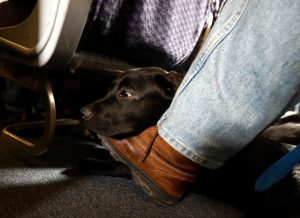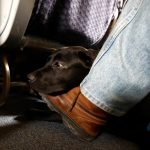DOT offers guidance for people traveling with emotional support animals
May 14, 2020

Airlines cannot limit the number of service animals on a flight, but will be allowed to deny boarding to an animal that is too large, too heavy or younger than four months, according to guidance provided Thursday by the U.S. Department of Transportation.
Officials are developing new rules governing what types of animals will be allowed to accompany passengers on flights and what documentation will be required to determine whether the animal’s presence is a legitimate need.
Proposed regulations are expected to be released by the department later this year and it’s possible new rules could be in place next summer or fall, officials said.
Until then, the information released Thursday is designed to clarify rules already in place.
The department’s work comes at a time when the definition for what is considered a service animal has grown to include animals travelers say they need for emotional and psychological support when flying. As a result, the number of animals traveling with passengers has grown dramatically, leading to conflict and sometimes injury.
According to the industry trade group, Airlines for America, the number of emotional support animals traveling aboard commercial flight increased from 481,000 in 2016 to 751,000 in 2017.
Last month, an American Airlines flight attendant received five stitches after she was bitten by an emotional support dog on a flight out of Dallas/Fort Worth. DOT officials also said they have received reports of severe biting incidents in which children have been severely scarred.
“Today’s action by the Department of Transportation is an important step to address what has become a mess of animals loose in the aircraft cabin,” said Sara Nelson, international president of the Association of Flight Attendants-CWA. “Clear rules are necessary to ensure access to service animal assistance for people with disabilities and our veterans, while maintaining the safety, health and security of all passengers and crew on board our planes.”
Service animals are animals that have been trained to perform a certain function, and under the Americans With Disabilities Act, reasonable accommodations must be made for a person using one. No training is required for emotional support animals, which has led to questions about their legitimacy.
Under current rules:
- Airlines are not allowed to ban certain breeds of service animals but can prevent an animal from flying if it determines that the specific animal poses a threat.
- Airlines can require documentation related to an animal’s training and behavior, as well as vaccination, as long as the documentation would enable the airline to determine whether the animal poses a direct threat to the health or safety of others. However, the documentation requirement cannot be “overly restrictive” or “unduly restrict” passengers from traveling with their service animals.
- Airlines can require people traveling with emotional support animals to go through lobby check-in. Travelers with emotional or psychiatric support animals may also be required to check in one hour before check-in begins for regular passengers. This rule does not apply to travelers with service animals.
- Airlines can deny boarding to an animal that is too large or too heavy but cannot categorically ban animals over a certain weight. Airlines also can ban service animals younger than four months.
- Airlines can require passengers with animals on flights eight hours or longer to provide documentation or proof that an animal won’t need to relieve itself or can relieve itself in a way that doesn’t create a health or sanitation issue on a flight. Airlines cannot automatically prohibit service animals on flights of eight or more hours.
- Airlines cannot limit the number of service animals on a flight.
- Airlines are not required to accept exotic animals, including snakes, ferrets, sugar gliders, spiders, rodents and reptiles.
- Airlines are not required to transport emotional or psychiatric support animals unless the passenger provides medical documentation of their need as specified under current rules.
- Travelers who plan to travel with emotional support animals must give airlines advance notice.
- Travelers can bring up to three service animals on a flight.
DOT officials said that airlines will have 30 days to revise their rules to meet DOT’s current requirements. Officials said they will continue to review all complaints, but given their resources will focus their efforts on cases involving the most common service animals — dogs, cats and miniature horses.
“Airlines for America applauds the Department of Transportation’s enforcement guidance on emotional support animals (ESAs),” a spokesman for the trade group said. “With over a million passengers bringing ESAs on flights last year, airlines and airports saw a sharp increase in incidents such as biting and mauling by untrained animals. The DOT’s guidance is an important step toward addressing this growing problem and ensuring a safer and healthier travel experience for all.”
The questions of which animals should be allowed to travel in the main cabin of an airplane has been controversial. The department’s Advisory Committee on Accessible Air Transportation, established in 2016, took up but was unable to resolve the issue of which species should be allowed.
In a previous statement, A4A said the Department of Transportation should ” … define ‘service animals’ as trained service dogs, which would harmonize DOT’s definition with that of the more generally applicable Americans With Disabilities Act.” The group is also seeking to limit the types of emotional support and psychiatric service animals that must be accommodated “because these animals cause the majority of in-flight disruptions.”
However, groups advocating for those with disabilities have argued for continued flexibility, saying there should be a case-by-case look at which animals are appropriate companions.






